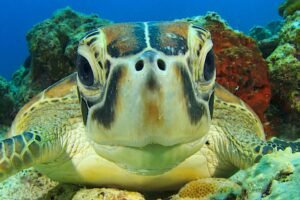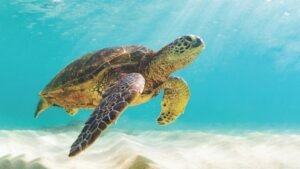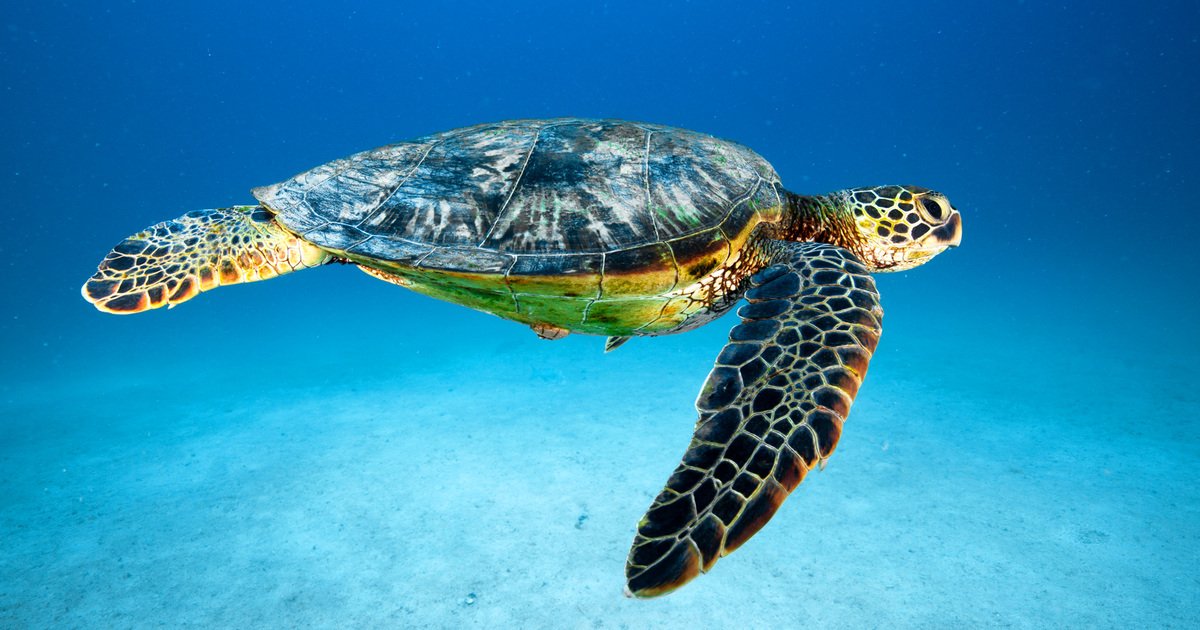Introduction to Green Turtles
Green turtles, scientifically known as Chelonia mydas, are distinguished members of the marine turtle family. Recognizable by their smooth, teardrop-shaped carapace and paddle-like flippers, green turtles exude a serene grace as they navigate the ocean currents. These majestic creatures exhibit a unique olive to dark green hue, which, contrary to popular belief, is not the origin of their name. Instead, it is the greenish color of their body fat, derived from their primarily herbivorous diet, that lends them their moniker.
Green turtles are a vital component of marine ecosystems, playing crucial roles in maintaining the health of seagrass beds and coral reefs. Their presence spans across tropical and subtropical oceans worldwide, from the Atlantic and Pacific Oceans to the Indian Ocean. They are frequently sighted in the warm waters of the Caribbean, the coasts of Southeast Asia, and the Great Barrier Reef in Australia.
Understanding the behaviors and habits of green turtles is paramount to conservation efforts. These ancient mariners are migratory by nature, often traveling vast distances between their feeding grounds and nesting sites. This extensive range makes them particularly susceptible to threats such as habitat destruction, climate change, and bycatch in fishing operations. By studying their breeding and feeding habits, scientists and conservationists can develop targeted strategies to protect these vulnerable species and ensure their survival for generations to come.
As stewards of the ocean, it is our responsibility to safeguard the delicate balance of marine life. Through education and concerted conservation efforts, we can contribute to the preservation of green turtles and the myriad other species that rely on healthy ocean ecosystems. The insights gained from studying green turtles not only enrich our understanding of these remarkable creatures but also underscore the broader significance of marine conservation in fostering a sustainable future.
Fact 1: Green Turtles’ Unique Diet
Green turtles are predominantly known for their herbivorous diet, particularly as adults. These majestic marine creatures primarily feast on seagrasses and algae, making them vital contributors to the health of marine ecosystems. As juveniles, however, their diet is more omnivorous, consisting of both plant matter and small animals such as jellyfish and crustaceans. This dietary shift from omnivory to herbivory is a fascinating aspect of their life cycle.
As green turtles mature, their digestive systems adapt to efficiently process the fibrous content of seagrasses and algae. This dietary specialization not only supports their nutritional needs but also plays a crucial role in shaping marine environments. By grazing on seagrasses, green turtles prevent these underwater meadows from becoming overgrown, thus maintaining their health and productivity. Healthy seagrass beds, in turn, provide essential habitat and nursery grounds for a multitude of marine species, enhancing biodiversity.
The consumption of algae by green turtles also contributes to the balance of coral reef ecosystems. By controlling algal growth, they help to prevent algae from outcompeting corals for space and resources. This interaction underscores the importance of green turtles in fostering resilient and thriving marine habitats. Additionally, their feeding habits promote nutrient cycling within these ecosystems, further supporting their stability and productivity.
Understanding the unique diet of green turtles highlights their ecological significance and the intricate connections they maintain within their habitats. These insights underscore the need for continued conservation efforts to protect green turtle populations and, by extension, the health of the marine ecosystems they help sustain. As we deepen our knowledge of these remarkable creatures, it becomes clear that their dietary preferences are not just a matter of survival but are integral to the well-being of marine life as a whole.
Fact 2: Long Migration Journeys
Green turtles are renowned for their extraordinary migratory patterns, often embarking on journeys that span thousands of miles between their feeding grounds and nesting sites. These remarkable reptiles traverse vast oceanic expanses with impressive navigational abilities, demonstrating a sophisticated understanding of marine environments.
One of the most well-known migration routes is between the feeding grounds in the coastal waters of Brazil and the nesting sites on Ascension Island in the Atlantic Ocean. This route exemplifies the green turtle’s capacity to endure long-distance travel, covering approximately 1,400 miles (2,250 kilometers) each way. Despite the challenges posed by such extensive voyages, green turtles consistently return to their natal nesting sites, a phenomenon known as natal homing.
The challenges faced by green turtles during migration are substantial. They must navigate complex ocean currents, which can either aid or impede their progress. Additionally, they are vulnerable to predation by larger marine animals, such as sharks, and human-induced threats, including fishing nets and marine pollution. The ability of green turtles to successfully complete these migrations is a testament to their resilience and adaptability.
Researchers have made significant strides in tracking the migratory patterns of green turtles using satellite telemetry. For instance, a notable study tracked a female green turtle named Adelita, who swam from Mexico to Japan, covering over 9,000 miles (14,500 kilometers). This journey provided valuable insights into the extensive range and endurance of green turtles, highlighting their remarkable capability to navigate across entire ocean basins.
Understanding the migratory behavior of green turtles is crucial for conservation efforts. By identifying key feeding and nesting sites, as well as migration corridors, conservationists can implement measures to protect these critical habitats and mitigate the threats posed by human activities. The study of green turtles’ long migration journeys underscores the importance of international collaboration in marine conservation to ensure the survival of these magnificent creatures.
Fact 3: Breeding and Nesting Behavior
The breeding habits of green turtles are a remarkable aspect of their life cycle, underscoring the intricate relationship these creatures have with their environment. Female green turtles exhibit a fascinating phenomenon known as natal homing, where they return to the very beach where they were born to lay their eggs. This extraordinary navigational feat remains a subject of extensive scientific study, revealing the deep-seated instincts that drive these ancient mariners.
Green turtles typically engage in nesting activities every 2 to 4 years, with the nesting season varying by geographic location but generally occurring during the warmer months. During each nesting season, a female may lay several clutches of eggs, each containing an average of 100 to 120 eggs. The eggs are deposited in carefully excavated nests in the sand, which the female covers before returning to the ocean.
The incubation period for green turtle eggs ranges from approximately 45 to 70 days, influenced by factors such as sand temperature and moisture levels. Warmer temperatures tend to speed up the incubation process, while cooler conditions may extend it. Once the incubation period concludes, the hatchlings emerge from their nests, usually at night to reduce the risk of predation.
The journey from nest to sea is fraught with danger for the hatchlings. They must navigate a myriad of obstacles, including predators like birds and crabs, as well as human-made hazards such as beachfront lighting which can disorient them. Only a small percentage of hatchlings survive this treacherous trek to reach the relative safety of the ocean.
Understanding the breeding and nesting behavior of green turtles is crucial for their conservation. Protecting nesting sites and mitigating human impacts are essential steps in ensuring that future generations of green turtles can continue to thrive. By safeguarding these vital habitats, we contribute to the preservation of a species that has been an integral part of marine ecosystems for millions of years.
Fact 4: Temperature-Dependent Sex Determination
One of the most fascinating aspects of green turtles is their temperature-dependent sex determination (TSD). Unlike mammals, where sex is determined genetically, green turtles rely on the temperature of the sand in which their eggs are incubated to determine the sex of their hatchlings. This unique biological phenomenon means that warmer sand temperatures typically result in a higher proportion of female hatchlings, whereas cooler sand temperatures tend to produce more males.
During the critical period of incubation, usually the middle third of the development process, the temperature of the surrounding environment plays a pivotal role. For green turtles, the pivotal temperature is approximately 29°C (84°F). At this temperature, the nest produces an equal ratio of male and female hatchlings. Temperatures above this pivotal point skew the ratio towards females, while those below it favor the emergence of males. This delicate balance is crucial for maintaining healthy population dynamics within green turtle communities.
However, the implications of climate change on TSD cannot be overstated. As global temperatures rise, the natural nesting environments of green turtles are becoming increasingly warmer. This shift threatens to disrupt the balanced sex ratios, potentially leading to a disproportionate number of female hatchlings. Such an imbalance poses significant risks to the future breeding success and genetic diversity of green turtle populations. Conservationists are actively studying these trends to develop strategies aimed at mitigating the impacts of climate change on these vulnerable marine reptiles.
In summary, temperature-dependent sex determination is a remarkable adaptation in green turtles that underscores the sensitivity of their reproductive biology to environmental changes. Understanding and addressing the effects of climate change on TSD is essential for the conservation and sustainability of green turtle populations worldwide.
Fact 5: Lifespan and Growth Rates
Green turtles are remarkable creatures, known for their impressive longevity. In the wild, these marine reptiles can live for more than 80 years. This extensive lifespan is a testament to their resilience and adaptability in diverse marine environments. However, reaching such an advanced age is not without its challenges. The journey from hatchling to mature adult is fraught with obstacles that can significantly influence their growth rates and overall survival.
From the moment they hatch, green turtles embark on a perilous journey. Hatchlings, which emerge from their nests on sandy beaches, are highly vulnerable to predation. Birds, crabs, and fish pose substantial threats as these tiny turtles make their way to the ocean. Once in the water, they must avoid marine predators such as sharks and large fish. Despite these dangers, a small percentage of hatchlings manage to survive and grow.
During the early stages of their life, green turtles experience rapid growth. As juveniles, they feed primarily on invertebrates and small marine organisms. This diet provides the necessary nutrients for their development. As they grow, their diet shifts primarily to seagrasses and algae, which are abundant in their natural habitats. This dietary change is crucial as it supports their continued growth and overall health.
The growth rate of green turtles is influenced by various factors, including the availability of food, environmental conditions, and genetic predisposition. In optimal conditions, green turtles can grow several centimeters each year. However, environmental threats such as habitat destruction, pollution, and climate change can adversely affect their growth and development. The loss of nesting beaches and feeding grounds can significantly reduce their chances of reaching maturity.
Despite these challenges, green turtles exhibit remarkable adaptability. Conservation efforts aimed at protecting their habitats and reducing human-induced threats have been instrumental in supporting their populations. Understanding the factors that influence the lifespan and growth rates of green turtles is essential for their continued survival and conservation.
Fact 6: Social Behavior and Interaction
Green turtles exhibit a variety of social behaviors that are as fascinating as they are complex. One of the most observable behaviors is basking in the sun on beaches. This activity serves multiple purposes, including thermoregulation and aiding in the digestion of their food. By basking, green turtles can elevate their body temperature, which helps them become more active in cooler waters. This behavior is often seen in more temperate regions where water temperatures can be less than ideal for these reptiles.
Another intriguing aspect of green turtle social behavior is their tendency to float near the surface of the water. This floating behavior not only helps in thermoregulation but also aids in resting and reducing energy expenditure. During these restful periods, green turtles can be seen drifting in groups, suggesting a level of social interaction that goes beyond mere survival. These groupings may offer additional benefits such as protection from predators.
Communication among green turtles is subtle yet effective. They utilize a combination of visual and tactile signals to interact with each other. For instance, during the breeding season, males and females engage in intricate courtship dances, which involve gentle nuzzles and flipper touches. These interactions are believed to strengthen the bonds between mating pairs and increase the chances of successful reproduction.
Green turtles also exhibit remarkable navigation skills, which are essential for their long migrations between feeding and breeding grounds. They rely on Earth’s magnetic fields, the position of the sun, and even the unique scent of their natal beaches to find their way. This exceptional ability to navigate helps them maintain social connections with their native populations and ensures the continuity of their species.
Interactions with other marine species are equally noteworthy. Green turtles often share their habitats with a variety of fish and other marine animals. They are known to participate in symbiotic relationships, such as allowing cleaner fish to remove parasites from their shells. These interactions illustrate the green turtle’s role in maintaining the balance of the marine ecosystem.
Fact 7: Conservation Efforts and Challenges
Conservation efforts for green turtles have been extensive and multifaceted, encompassing legal protections, habitat conservation, and strategies to reduce bycatch in fisheries. Various international agreements, such as the Convention on International Trade in Endangered Species (CITES) and the Convention on Migratory Species (CMS), have played pivotal roles in providing a legal framework for the protection of green turtles. These agreements help to regulate and monitor the trade of green turtle products and ensure that countries adhere to sustainable practices.
Habitat conservation is another critical aspect of protecting green turtles. Efforts to safeguard nesting beaches and feeding grounds are essential, as these areas are crucial for the survival and reproduction of the species. Several organizations and government bodies have established marine protected areas (MPAs) to preserve these vital habitats. Additionally, community-based conservation programs work closely with local populations to promote sustainable practices and reduce human impact on green turtle habitats.
Bycatch, the accidental capture of non-target species in fishing gear, poses a significant threat to green turtles. To address this issue, various mitigation measures have been implemented, including the use of turtle excluder devices (TEDs) in shrimp trawling and modifications to longline fishing gear. These measures have proven effective in reducing the incidental capture of green turtles and other marine species.
Despite these efforts, green turtles continue to face numerous challenges. Climate change, for instance, has led to rising sea levels, which threaten nesting beaches, and increasing ocean temperatures, which can affect the sex ratio of hatchlings. Pollution, particularly plastic debris, poses a significant risk as turtles often mistake plastic for food. Illegal hunting and poaching for their meat, shells, and eggs remain persistent threats in some regions.
Nevertheless, there have been notable successes in green turtle conservation. Programs such as the Sea Turtle Conservancy’s Tortuguero program in Costa Rica have made significant strides in increasing nesting success rates and hatchling survival. International cooperation and the support of non-governmental organizations (NGOs) have been instrumental in these achievements. By working together, these entities have been able to implement effective conservation strategies that ensure the continued survival of green turtles.
Conclusion: The Importance of Green Turtles
Green turtles, with their distinctive breeding and feeding habits, play an essential role in maintaining the health of marine ecosystems. Their unique characteristics, such as their herbivorous diet, contribute to the balance of seagrass beds and coral reefs. These vibrant habitats are not only crucial for marine life but also for the overall health of our oceans. The remarkable migratory patterns of green turtles highlight their resilience and the complex nature of their life cycles, making them a subject of interest for ongoing research and conservation efforts.
Understanding the critical role green turtles play underscores the need for continued conservation initiatives. Protecting these creatures ensures the sustainability of marine ecosystems, which in turn supports biodiversity and the livelihoods of communities that depend on the ocean. Human activities, such as pollution, coastal development, and climate change, pose significant threats to green turtle populations. Therefore, it is imperative to support conservation programs that aim to mitigate these impacts and promote the recovery of green turtle populations.
As individuals, we can contribute to the protection of green turtles and the marine environment by being mindful of our actions. Reducing plastic use, supporting sustainable fishing practices, and participating in beach clean-ups are practical steps we can take. Additionally, advocating for policies that protect marine habitats and funding research initiatives are crucial in ensuring the long-term survival of green turtles.
In conclusion, green turtles are more than just fascinating creatures; they are vital to the health of our oceans. By supporting conservation efforts and making conscious choices, we can help safeguard these incredible animals for future generations. The collective impact of our actions can ensure that green turtles continue to thrive, maintaining the balance of marine ecosystems and the beauty of our planet’s oceans.
